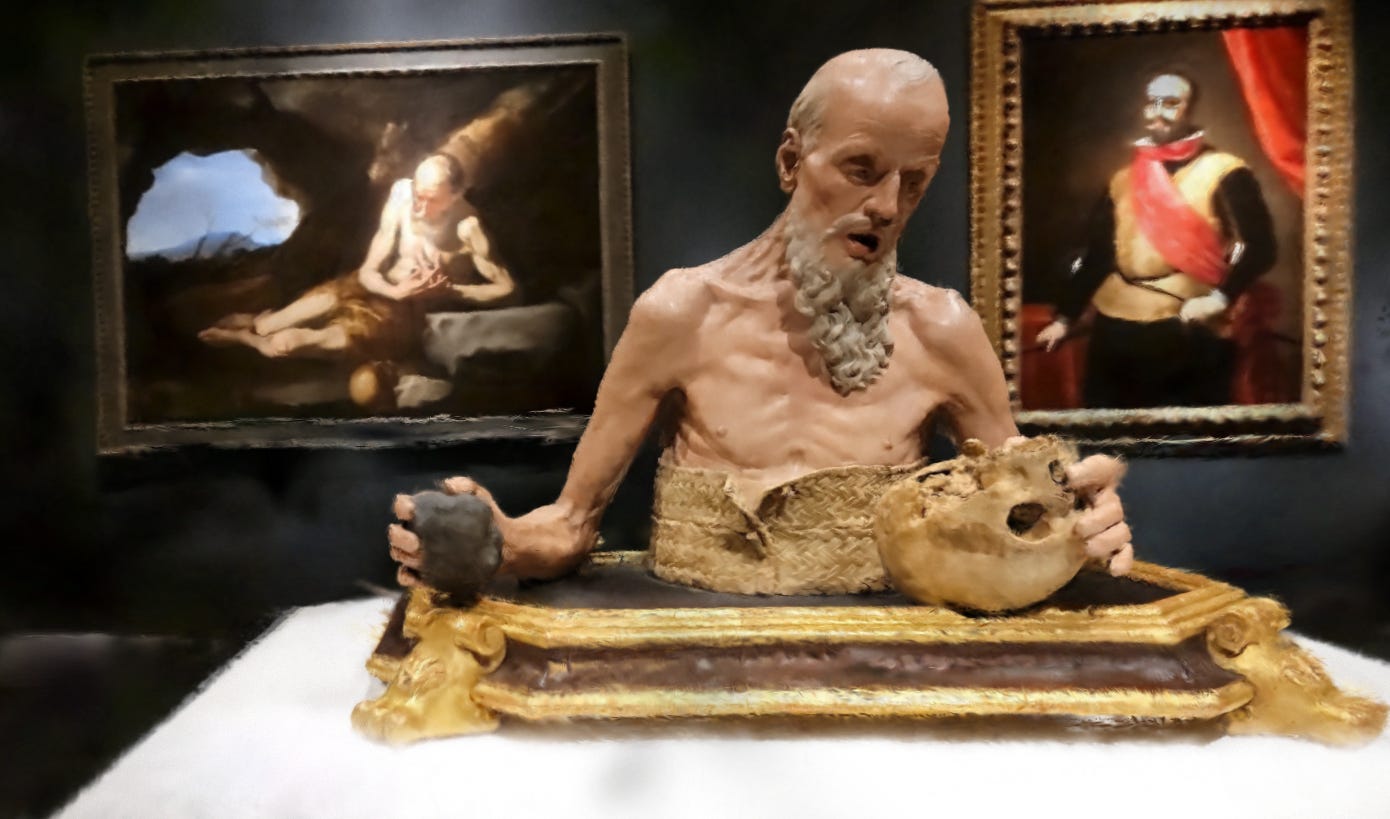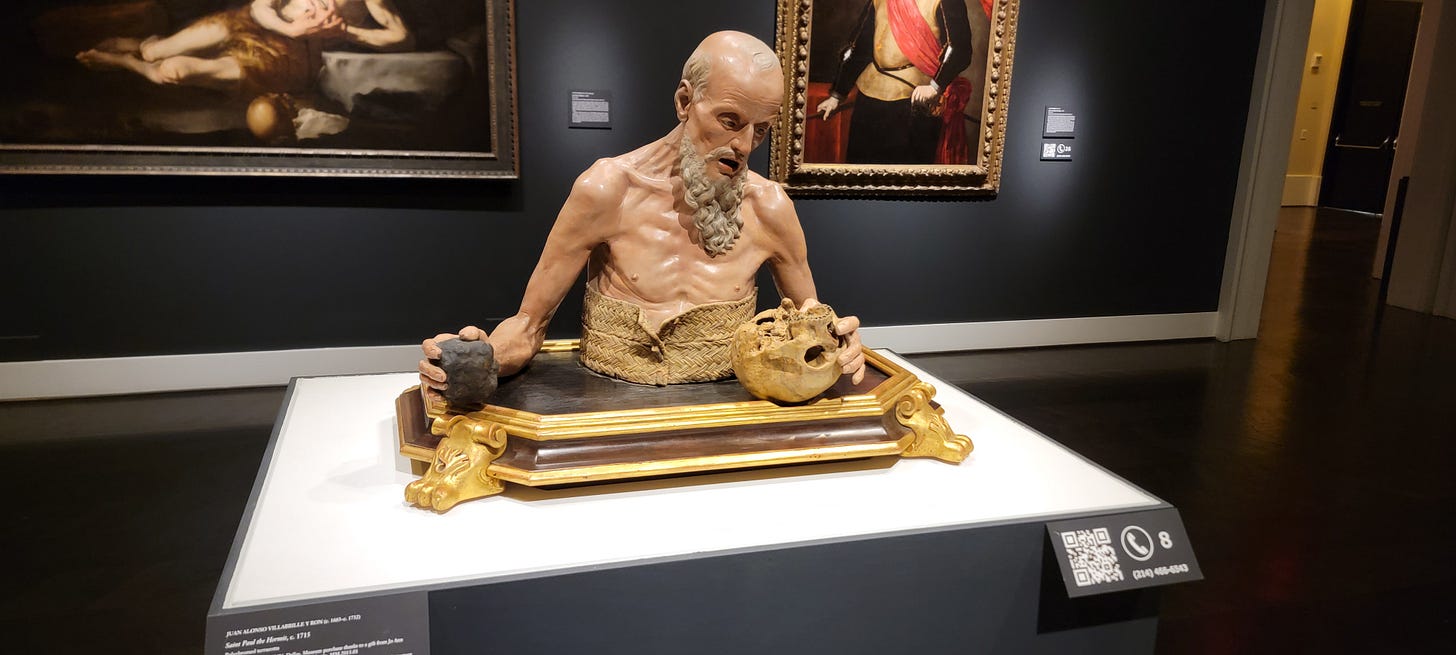Filial obligations have had me crisscrossing the country over the last several weeks. I was able to escape them for a few hours on Friday to visit the Meadows Museum in Dallas. This is an excellent small museum dedicated to Spanish art, with works by Goya, Velázquez, Ribera, and others. It also has a painted terracotta sculpture from c. 1715 by Juan Alonso Villabrille y Ron of St. Paul the Hermit. The label reads:
Juan Alonso Villabrille y Ron is considered by many to be one of the most important sculptors of the Baroque in Madrid in the first decades of the eighteenth century. Not much is known about his life and artistic education, and although many works are referenced in archival documents, very few are known. Descriptions of sculptures attributed to Villabrille y Ron often address the objects’ extreme realism, pious sentiment, anatomical accuracy, virtuous carving, and pathetic gestures. These are also qualities of this terracotta sculpture, believed to represent Saint Paul the Hermit, the first hermit saint of the Christian church.
In this bust-length image, the saint is presented as a balding, gray-haired, wizened man in the midst of contemplative prayer. He holds what appears to be a stone in his right hand and an extremely realistic skull in his left hand, both common attributes of a penitent saint. He looks intently at the skull with an expression of deep sorrow that is heightened by his bulging eyes and sunken eyelids. His sunburned skin is a result of his life in the wilderness; his protruding cheekbones, collarbone and spinal column reinforce the emaciated appearance of the ascetic for whom fasting was a key part of religious experience. Even minute details of his anatomy are naturalistically rendered; for example the bluish veins that are easily seen through his frail skin. Nearly half of the saint’s trunk is covered by a realistically executed woven-reed garment that stands out as Saint Paul’s most distinguishing attribute.
This is Paul of Thebes, not Paul the Apostle. The clue is the garment of woven reeds. Here’s a photo.
Behind it you can see part of a Jusepe de Ribera oil of the same subject.
In the splat, you can also see hints of the Ribera, as well as the admiring figure of longtime reader Tim McClure, with whom I had some fine conversations in front of some magnificent art. We also got to catch the last days of “The Sense of Beauty: Six Centuries of Painting from Museo de Arte de Ponce.” El museo is under reconstruction in the aftermath of the 2020 earthquakes. In the meantime, highlights of the collection are traveling, including Flaming June.

While the highlight of the painting was the impasto reflections of sunlight on the water in the background, I was entranced by the toes tempting the viewer from the other side of the orange gossamer.
In the midst of death, there is this glory. It is a comfort to behold.
Dissident Muse Journal is the blog of Dissident Muse, a publishing and exhibition project by Franklin Einspruch. Content at DMJ is free, but paid subscribers keep it coming. Please consider becoming one yourself, and thank you for reading.
Our current title in the Asynchronous Studio Book Club is Art in America 1945-1970: Writings from the Age of Abstract Expressionism, Pop Art, and Minimalism edited by Jed Perl. For more information, see the ASBC homepage.
The current exhibition in the Dissident Museum is David Curcio: The Point of the Needle.







Any Zubaran? ❤️
If not for the woven reed garment, it could easily be a St. Jerome. As for the Leighton, I believe it wound up in Puerto Rico because the museum's founder bought it at a time when anything Victorian was very unfashionable, and he probably got it quite cheap. So it goes.
Alas, this is all "old stuff" of precious little interest, if any, to the fashionably "cutting edge." Of course, what they're into is not art as such but whatever projects the right image and message. I suppose one should feel sorry for them, but they're not merely wrong but twisted.